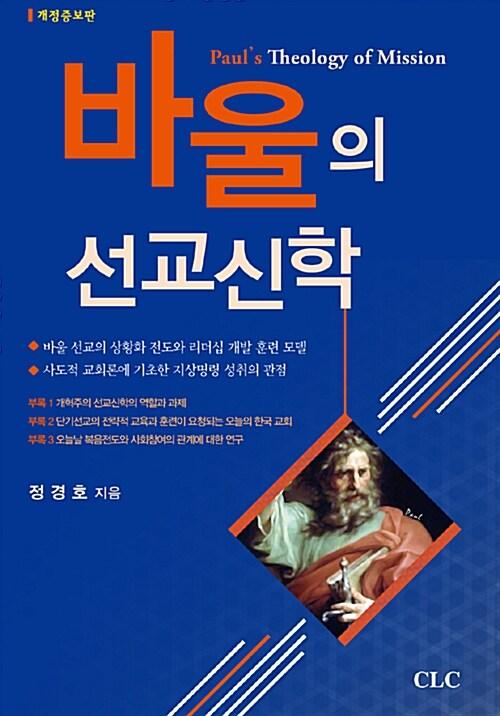책 이미지

책 정보
· 분류 : 국내도서 > 종교/역학 > 기독교(개신교) > 기독교(개신교) 선교/전도
· ISBN : 9788934115366
· 쪽수 : 520쪽
· 출판일 : 2016-04-25
목차
Foreword 3
(Dr. Sung-Tae Kim, Professor of Missiology at Chongshin Univ. Theological Seminary)
Preface to the English Edition 8
Preface to the 2nd Korean Edition 9
Preface to the 1st Korean Edition 12
Chapter 1 Introduction:
The Need for a Missionary Model with an Apostolic Approach 15
1. Two Structures of Missions as the Essence of the Church 15
2. The Rights and Wrongs of Mission 18
3. Why Paul’s Way? 19
4. The Purpose and Value of Researching Paul’s Theology of Mission 25
5. The Methods for Researching Paul’s Theology of Mission and its Limits 27
Chapter 2 The Historical Background of the Age of Paul’s Mission 35
1. Politics and History in the Time of Paul 36
2. Society and Culture in the Time of Paul 44
3. Religion and Philosophy in the Time of Paul 49
4. Judaism and Hellenism in the Time of Paul 60
5. Paul’s Interpretation of the Relationship between Law and the Gospel 70
6. The Significance of the Early Christianity in the Roman World 74
7. The Development of the Early Church in the Time of Paul 76
8. Conclusion 79
Chapter 3 Understanding Paul’s Mission Ideology 91
1. Paul’s Life and Intellectual Background 92
2. In Defense of Paul’s Apostleship 102
3. The Testimony of Paul’s Mission According to the Acts 106
4. Theological Ideas at the Heart of Paul’s Mission 119
5. Conclusion 130
Chapter 4 The Nature of the Apostolic Church for Paul’s Mission 137
1. The Priestly Ecclesiology of the Old Testament 140
2. The Old Testament and Prophetic Ecclesiology 153
3. Jesus’ Great Commission as the Foundation of the Apostolic Church 163
4. The Apostolic Church Viewed from the Perspective
of the Great Commission 171
5. The Apostolic Ecclesiology in Paul’s Missional Community 186
6. Paul’s Apostolic Church and the Great Commission 203
7. Conclusion 204
Chapter 5 Understanding Paul’s Model for Contextualization 219
1. The Definition and Paradigm of Contextualization 222
2. The Need for Paul’s Missional Contextualization 240
3. The Principles of Paul’s Missional Contextualization 251
4. The Reality of Paul’s Missional Contextualization 258
5. A Model for Contextualization in Paul’s Mission 270
6. Paul’s Contextualization & the Great Commission 281
7. Conclusion 283
Chapter 6 Understanding Paul’s Model for Leadership Development 291
1. The Definition, Types and Models of Leadership Development 294
2. The Basic Patterns for Paul’s Leadership Development 307
3. The Principles of Leadership in Paul’s Mission 315
4. The Reality of Leadership Development in Paul’s Mission 320
5. A Model For Leadership Development in Paul’s Missional Community 329
6. Paul’s Leadership Development and the Great Commission 337
7. Conclusion 338
Chapter 7 Applying Paul’s Missional Theology to Modern Ministry 347
1. Theological Issues for Modern Mission Work 348
2. Application for Modern Missionary Work 361
3. The Suitability of Paul’s Missiology for Modern Missionaries 375
4. Conclusion 376
Chapter 8 Conclusion: The Future of Korean Missional Theology 383
1. Summary 384
2. The Tasks Ahead 387
Appendix 1. The Role & Task of Reformist Mission Theology 393
Appendix 2. The Korean Church of Today in Need of Strategic Education and Training for Short Term Missions 423
Appendix 3. A Study of the Relationship Between Modern Evangelism & Social 457
References 489
책속에서
Even from the time of Augustus, Paul used the Roman Empire as his stage and contextualized the Gospel message in both Europe and Asia and developed leaders through pioneering churches. It is safe to suggest that Augustus had in fact set the foundation for Paul’s ministry. Despite these positive notes, Augustus also strengthened imperial authority and spread the idea of emperor worship, and was referred to as kurios which literally means Lord, a title that the Christians used to refer to Jesus Christ, giving the Romans an excuse to persecute them.
All of Paul’s missionary work takes place during the emperors Tiberius, Caligula, Claudius and Nero. The apostle records that he recognizes the political authority of the empire and urges his followers to submit to Roman power in his book of Romans.
Paul’s mission theology was fulfilled in every area of the apostolic community and bore fruit. He succeeded in apostolic contextualization to effectively communicate the Gospel to all peoples in all places without tarnishing the central message of the resurrection of Jesus Christ, the only way to salvation. In addition, the apostle poured all his energy into training leaders from the believers who responded well to the Gospel ? this is his leadership development ministry.
The apostle’s missional efforts formed the apostolic ecclesiology and it appeared in his community. He expressed the attributes and functions of the church as the body of Christ, the incarnation, Kerygma, Didache, Diakonia, Oikos, a Spirit-filled community, and as a community of love that is centered round relationships. This is because the church is the community of Jesus Christ the greatest missionary and is therefore “genetically”missional. The church exists because of God’s mission.
The apostolic church had a fully-fledged apocalyptic atmosphere about it and continued to develop this while working to fulfill the Great Commission. In particular, Paul acknowledged the authority of apostleship and considered it grace
from God. The apostles received the calling for mission and Paul claimed he was called to be the missionary to the Gentiles. Apostolic ministry does not only involve setting the foundation for the church, but also contributing to actually building the church on the foundation. Jesus, the apostolic church, and mission share the same roots and can be understood in the same context.






































